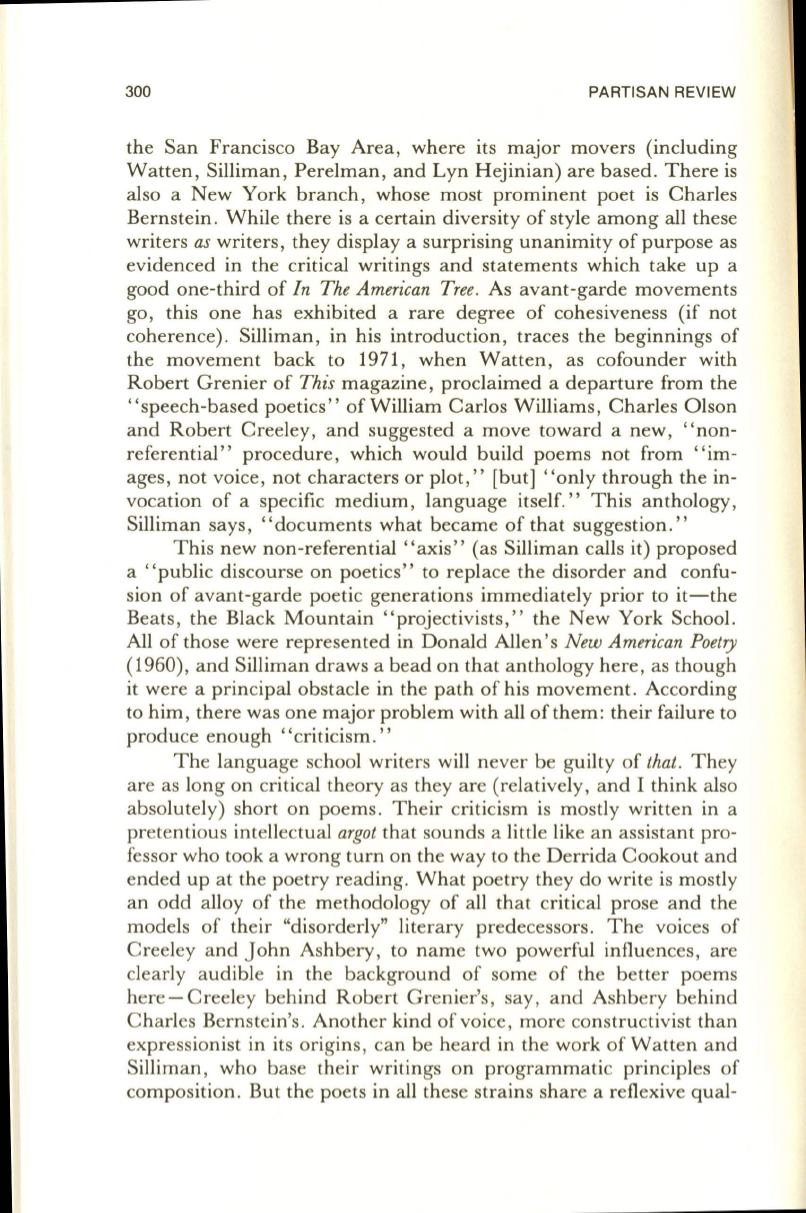
300
PARTISAN REVIEW
the San Francisco Bay Area, where its major movers (including
Watten, Silliman, Perelman, and Lyn Hejinian) are based . There is
also a New York branch, whose most prominent poet is Charles
Bernstein. While there is a certain diversity of style among all these
writers
as
writers, they display a surprising unanimity of purpose as
evidenced in the critical writings and statements which take up a
good one-third of
In The American Tree.
As avant-garde movements
go , this one has exhibited a rare degree of cohesiveness (if not
coherence) . Silliman, in his introduction, traces the beginnings of
the movement back to 1971, when Watten, as cofounder with
Robert Grenier of
This
magazine, proclaimed a departure from the
"speech-based poetics" of William Carlos Williams, Charles Olson
and Robert Creeley, and suggested a move toward a new, "non–
referential" procedure, which would build poems not from "im–
ages, not voice, not characters or plot," [but] "only through the in–
vocation of a specific medium, language itself." This anthology,
Silliman says, "documents what became of that suggestion."
This new non-referential "axis" (as Silliman calls it) proposed
a "public discourse on poetics" to replace the disorder and confu–
sion of avant-garde poetic generations immediately prior to it-the
Beats, the Black Mountain "projectivists," the New York School.
All of those were represented in Donald Allen's
New American Poetry
(1960), and Silliman draws a bead on that anthology here, as though
it were a principal obstacle in the path of his movement. According
to him, there was one major problem with all of them: their failure to
produce enough "criticism."
The language school writers will never be guilty of
that.
They
are as long on critical theory as they are (relatively, and I think also
absolutely) short on poems. Their criticism is mostly written in a
pretentious intellectual
argot
that sounds a little like an assistant pro–
fessor who took a wrong turn on the way to the Derrida Cookout and
ended up at the poetry reading. What poetry they do write is mostly
an odd alloy of the methodology of all that critical prose and the
models of their "disorderly" literary predecessors. The voices of
Creeley and John Ashbery, to name two powerful influences, are
clearly audible in the background of some of the better poems
here-Creeley behind Robert Grenier's , say, and Ashbery behind
Charles Bernstein's. Another kind of voice , more constructivist than
expressionist in its origins, can be heard in the work of Watten and
Silliman, who base their writings on programmatic principles of
composition. But the poets in all these strains share a reflexive qual-


